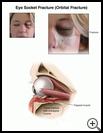
Eye Socket Fracture (Orbital Fracture)
________________________________________________________________________
KEY POINTS
- An orbital fracture means that your child has broken bones that surround his eye.
- Treatment may include medicine to prevent infection and treat pain and swelling. In some cases, your child may need surgery.
________________________________________________________________________
What is an eye socket fracture?
The eye socket, or orbit, is made up of the bones that surround the eye. If the bones around your child’s eye are hit hard enough, they can break. This is called an orbital fracture.
If your child’s eye socket is treated successfully, and the injury to your child’s eye or tissues around the eye was not too severe, your child may not have any long-lasting effects from an eye socket fracture. If an eye socket fracture is not treated, your child may have double vision or the eye may always look sunken in.
What is the cause?
Injuries that can cause an eye socket fracture include:
- Falls
- Car accidents
- Sports injuries
- Being punched or kicked in the eye
One type of eye socket fracture that may not look bad, yet can cause serious problems, is a trapdoor fracture. The bone under your child’s eye can swing down when broken and then swing shut, trapping the muscle that moves the eye down. Even if the bones do not look broken, a trapdoor fracture causes pain, severe double vision, nausea, and vomiting. This type of fracture is more common in children because their bones are more flexible than adult bones.
What are the symptoms?
Symptoms may include:
- Decreased vision or double vision
- Pain, bruising, drainage, tearing, bleeding, or swelling in and around your child’s eye, nose, or cheeks
- Numbness in your child’s eyelids, cheek, side of the nose, upper lip, teeth and gums
- Nausea and vomiting, which are more common in trapdoor fractures
- Trouble moving the eye in one or more directions
- Sunken eye, droopy eyelid, or an eye that bulges out
- Swelling caused by air under the skin and that feels crunchy when touched
How is it diagnosed?
Your eye care provider will ask about your child’s symptoms and your child’s injury, and do exams and tests such as:
- An exam using a microscope with a light attached, called a slit lamp, to look closely at the front and back of your child’s eye
- An exam using drops to enlarge, or dilate, the pupils and a light to look into the back of your child’s eyes
- Measurements to check the position of the injured eye compared with the normal eye
- CT scan which uses X-rays and a computer to show detailed pictures of the bones of the eye socket and any blood behind the eye
How is it treated?
Your healthcare provider may prescribe antibiotics to prevent infections. Your provider may also prescribe steroid pills to decrease swelling.
Some eye socket fractures need to be repaired and others do not. Your child’s fracture may need to be treated if:
- Your child’s eye is sunken in.
- Your child has severe double vision.
- A muscle is stuck between the broken bones.
- Many of the bones around your child’s eye are broken and need to be put back into the right position.
If your child’s eye was injured when the eye socket was broken, your child’s eye also may need treatment.
How can I take care of my child?
Follow the full course of treatment your healthcare provider prescribes. Also:
- To keep swelling down and help relieve pain, your provider may tell you to:
- Put an ice pack, gel pack, or package of frozen vegetables wrapped in a cloth on your child’s eye every 3 to 4 hours for up to 20 minutes at a time for the first day or two after the injury.
- Have your child sleep with his head up on extra pillows.
- Have your child avoid straining while lifting, having a bowel movement, passing urine, blowing his nose, sneezing, or coughing for the first few days.
- Take pain medicine, such as ibuprofen, as directed by your child’s provider. Check with your healthcare provider before you give any medicine that contains aspirin or salicylates to a child or teen. This includes medicines like baby aspirin, some cold medicines, and Pepto Bismol. Children and teens who take aspirin are at risk for a serious illness called Reye’s syndrome.
Ask your healthcare provider:
- How and when you will get your child’s test results
- How long it will take to recover
- If there are activities your child should avoid and when he can return to his normal activities
- How to take care of your child at home
- What symptoms or problems you should watch for and what to do if your child has them
Make sure you know when your child should come back for a checkup. Keep all appointments for provider visits or tests.
How can I prevent eye socket fractures?
- To help prevent severe eye injuries, make sure that your child wears safety eyewear when he:
- Works with power tools, chemicals, or splatter of any kind
- Plays sports such as paintball, racquetball, lacrosse, hockey, and fast-pitch softball
- Make sure that your child is always correctly secured in a car seat or always wears a seatbelt to decrease injuries from car accidents.
Last modified: 2016-10-31
Last reviewed: 2017-10-02

